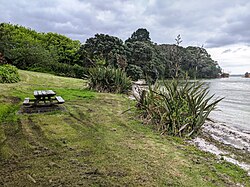Ongare Point
Ongare Point | |
|---|---|
Rural settlement | |
 Ongare Point beach on Tauranga Harbour | |
 | |
| Coordinates: 37°30′07″S 175°58′01″E / 37.502°S 175.967°E | |
| Country | New Zealand |
| Region | Bay of Plenty |
| Territorial authority | Western Bay of Plenty District |
| Ward | Katikati-Waihi Beach Ward |
| Community | Katikati Community |
| Electorates | |
| Government | |
| • Territorial Authority | Western Bay of Plenty District Council |
| • Regional council | Bay of Plenty Regional Council |
| Area | |
| • Total | 0.55 km2 (0.21 sq mi) |
| Population (2018 Census)[2] | |
| • Total | 117 |
| • Density | 210/km2 (550/sq mi) |
| Postcode(s) | 3170 |
Ongare Point is a rural settlement in the Western Bay of Plenty District and Bay of Plenty Region of New Zealand's North Island. It is on a headland on the eastern side of Tauranga Harbour, southeast of Katikati Entrance and opposite Matakana Island.[3]
A coastal walkway through a reserve connects Ongare Point to Kauri Point.[4] There is a small sandy beach.[5]
Ngāi Te Rangi's Ōngare Pā was attacked in 1842 by a war party of 50 men led by Tāraia Ngākuti Te Tumuhuia. The local chief Te Whanake and several followers were killed.[6]
Demographics
Ōngare Point-Kauri Point is defined by Statistics New Zealand as a rural settlement. Ongare Point covers 0.55 km2 (0.21 sq mi).[1] It is part of the wider Tahawai statistical area.[7]
| Year | Pop. | ±% p.a. |
|---|---|---|
| 2006 | 102 | — |
| 2013 | 102 | +0.00% |
| 2018 | 117 | +2.78% |
| Source: [2] | ||
Ongare Point had a population of 117 at the 2018 New Zealand census, an increase of 15 people (14.7%) since the 2013 census, and an increase of 15 people (14.7%) since the 2006 census. There were 54 households, comprising 63 males and 51 females, giving a sex ratio of 1.24 males per female. The median age was 59.6 years (compared with 37.4 years nationally), with 9 people (7.7%) aged under 15 years, 12 (10.3%) aged 15 to 29, 54 (46.2%) aged 30 to 64, and 42 (35.9%) aged 65 or older.
Ethnicities were 94.9% European/Pākehā, 10.3% Māori, 2.6% Pacific peoples, and 5.1% Asian. People may identify with more than one ethnicity.
Although some people chose not to answer the census's question about religious affiliation, 64.1% had no religion, 25.6% were Christian, and 2.6% were Muslim.
Of those at least 15 years old, 24 (22.2%) people had a bachelor's or higher degree, and 21 (19.4%) people had no formal qualifications. The median income was $30,300, compared with $31,800 nationally. 15 people (13.9%) earned over $70,000 compared to 17.2% nationally. The employment status of those at least 15 was that 39 (36.1%) people were employed full-time, 15 (13.9%) were part-time, and 3 (2.8%) were unemployed.[2]
References
- ^ a b "ArcGIS Web Application". statsnz.maps.arcgis.com. Retrieved 25 November 2022.
- ^ a b c "Statistical area 1 dataset for 2018 Census". Statistics New Zealand. March 2020. 7013535.
- ^ Harriss, Gavin (August 2022). Ongare, Bay of Plenty (Map). NZ Topo Map.
- ^ "Kauri Point – Ongare Point". motowalknz. 5 March 2016.
- ^ "Tauranga Harbour at Ongare Point". Land Air Water Aotearoa. Retrieved 25 November 2022.
- ^ Ballara, Angela. "Tāraia Ngākuti Te Tumuhuia". Dictionary of New Zealand Biography. Ministry for Culture and Heritage. Retrieved 25 November 2022.
- ^ 2018 Census place summary: Tahawai
- Pages using gadget WikiMiniAtlas
- Articles with short description
- Short description is different from Wikidata
- Use dmy dates from November 2022
- Use New Zealand English from November 2022
- All Wikipedia articles written in New Zealand English
- Infobox mapframe without OSM relation ID on Wikidata
- Coordinates on Wikidata
- Western Bay of Plenty District
- Populated places in the Bay of Plenty Region
- Populated places around the Tauranga Harbour
- Pages using the Kartographer extension